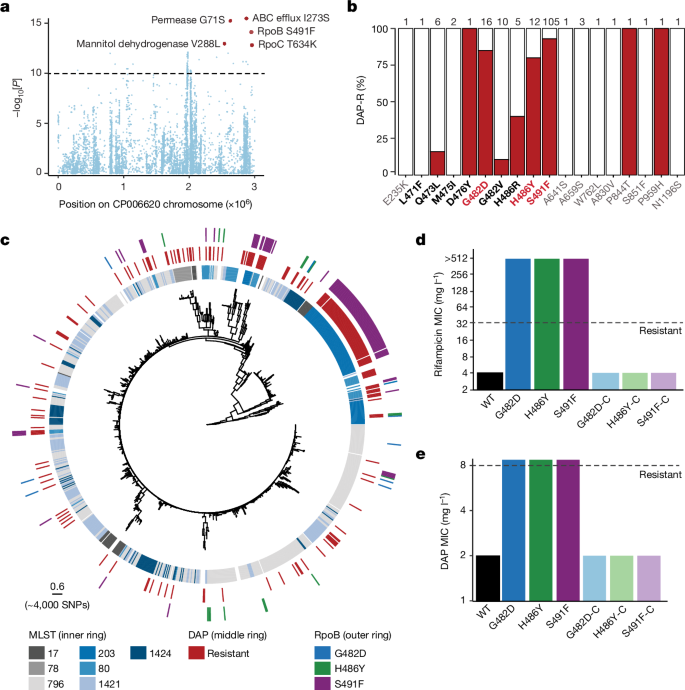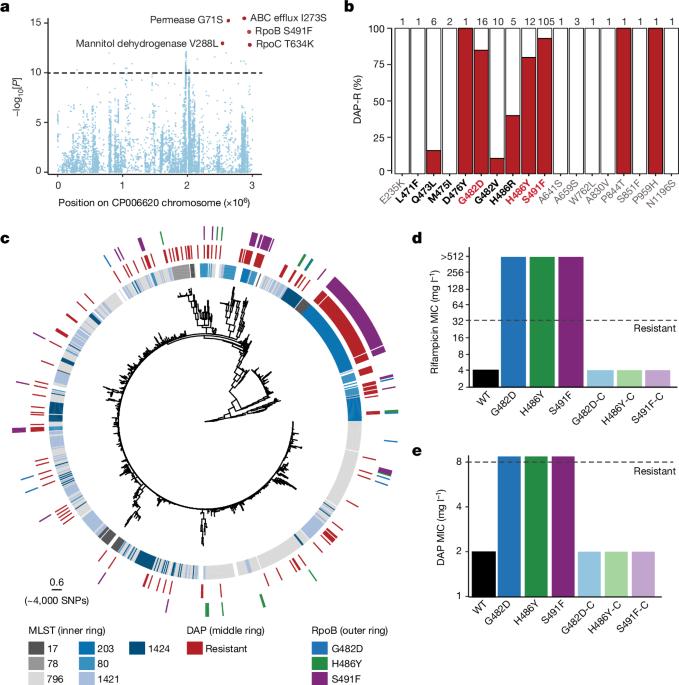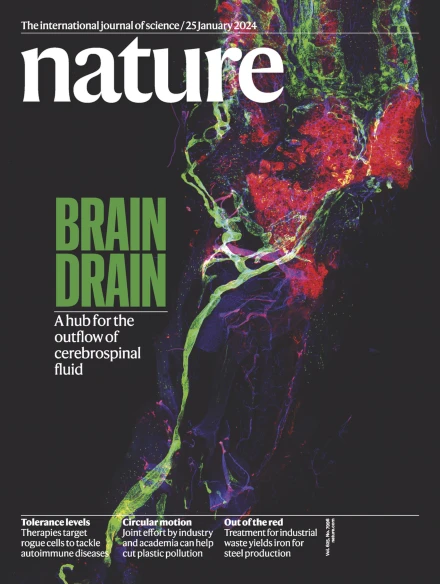利福昔明预防性治疗会导致最后一种抗生素达托霉素产生抗药性
IF 50.5
1区 综合性期刊
Q1 MULTIDISCIPLINARY SCIENCES
引用次数: 0
摘要
耐万古霉素肠球菌(VREfm)等多重耐药细菌病原体对人类健康构成严重威胁1。达托霉素是治疗 VREfm 感染的最后一种抗生素,其作用模式新颖2,但耐药性已被广泛报道,但原因不明。在这里,我们发现利福昔明(一种不相关的抗生素,用于预防肝病患者的肝性脑病3)会导致 VREfm 对达托霉素产生交叉耐药性。由于利福昔明的暴露,细菌 RNA 聚合酶内的氨基酸发生了变化,导致以前未定性的操作子(prdRAB)上调,从而导致细胞膜重塑,并通过减少与抗生素的结合而对达托霉素产生交叉耐药性。具有这些突变的 VREfm 在全球范围内传播,因此这也是一种主要的耐药机制。利福昔明一直被认为是产生抗生素耐药性的 "低风险 "药物。我们的研究表明,这一假设是错误的,利福昔明的广泛使用(尤其是在肝硬化患者中)可能会影响达托霉素的临床使用,而达托霉素是治疗耐多药病原体的主要最后手段。这些发现表明,意想不到的抗生素交叉耐药性如何会破坏旨在保护关键抗生素临床使用的全球战略。本文章由计算机程序翻译,如有差异,请以英文原文为准。


Rifaximin prophylaxis causes resistance to the last-resort antibiotic daptomycin
Multidrug-resistant bacterial pathogens like vancomycin-resistant Enterococcus faecium (VREfm) are a critical threat to human health1. Daptomycin is a last-resort antibiotic for VREfm infections with a novel mode of action2, but for which resistance has been widely reported but is unexplained. Here we show that rifaximin, an unrelated antibiotic used prophylactically to prevent hepatic encephalopathy in patients with liver disease3, causes cross-resistance to daptomycin in VREfm. Amino acid changes arising within the bacterial RNA polymerase in response to rifaximin exposure cause upregulation of a previously uncharacterized operon (prdRAB) that leads to cell membrane remodelling and cross-resistance to daptomycin through reduced binding of the antibiotic. VREfm with these mutations are spread globally, making this a major mechanism of resistance. Rifaximin has been considered ‘low risk’ for the development of antibiotic resistance. Our study shows that this assumption is flawed and that widespread rifaximin use, particularly in patients with liver cirrhosis, may be compromising the clinical use of daptomycin, a major last-resort intervention for multidrug-resistant pathogens. These findings demonstrate how unanticipated antibiotic cross-resistance can undermine global strategies designed to preserve the clinical use of critical antibiotics. Rifaximin use, particularly in patients with liver cirrhosis, may be compromising the clinical use of daptomycin.
求助全文
通过发布文献求助,成功后即可免费获取论文全文。
去求助
来源期刊

Nature
综合性期刊-综合性期刊
CiteScore
90.00
自引率
1.20%
发文量
3652
审稿时长
3 months
期刊介绍:
Nature is a prestigious international journal that publishes peer-reviewed research in various scientific and technological fields. The selection of articles is based on criteria such as originality, importance, interdisciplinary relevance, timeliness, accessibility, elegance, and surprising conclusions. In addition to showcasing significant scientific advances, Nature delivers rapid, authoritative, insightful news, and interpretation of current and upcoming trends impacting science, scientists, and the broader public. The journal serves a dual purpose: firstly, to promptly share noteworthy scientific advances and foster discussions among scientists, and secondly, to ensure the swift dissemination of scientific results globally, emphasizing their significance for knowledge, culture, and daily life.
 求助内容:
求助内容: 应助结果提醒方式:
应助结果提醒方式:


